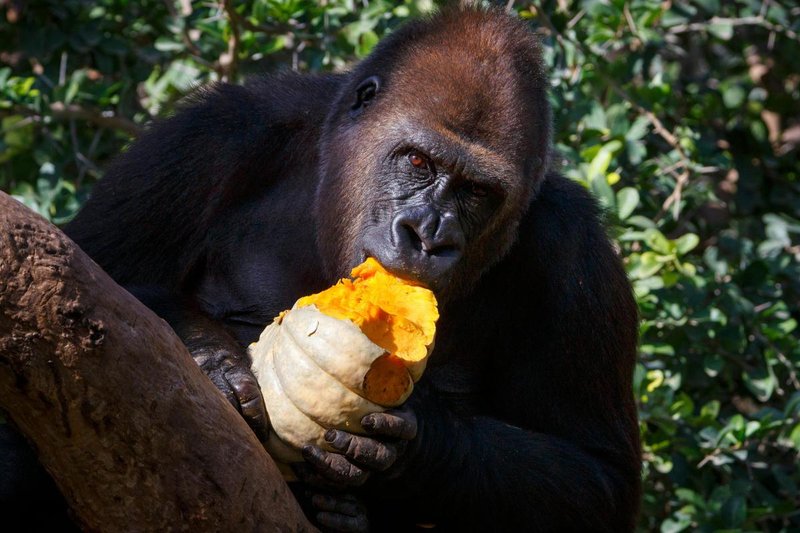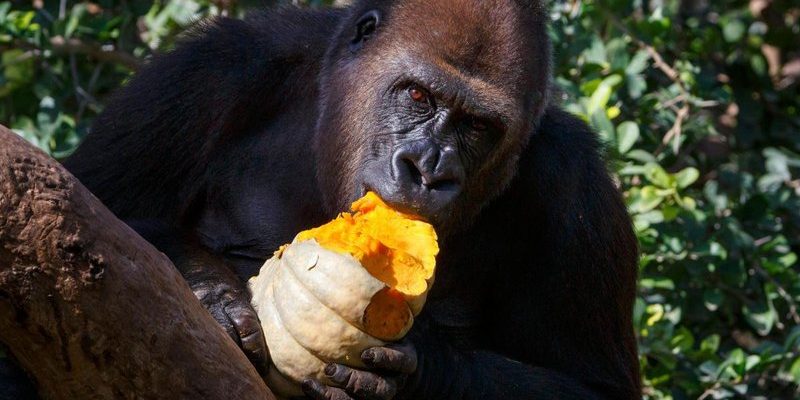
Imagine wandering through the lush jungles of Central Africa, surrounded by the sounds of chirping birds and rustling leaves. Now, think about the western gorilla navigating this vibrant world. They’re not just passive eaters; they actively seek out their meals, showcasing their intelligence and adaptability. So, what makes their diet unique, and how do they hunt for food? Let’s dive in!
What Do Western Gorillas Eat?
Western gorillas are primarily herbivores, which means the bulk of their diet comes from plants. They enjoy a variety of foods, including fruits, leaves, stems, and flowers. Interestingly, they have a strong preference for specific types of vegetation. For instance, they often munch on young leaves, which are tender and packed with nutrients.
Some key food sources in their diet include:
- Fruits: Gorillas love sweet fruits like bananas, berries, and figs. This sugary treat is not just a snack; it provides them with energy for their daily activities.
- Leaves: They consume a large number of leaves, preferring younger, softer ones that are easier to digest. This is why you often find them foraging in dense foliage.
- Stems and Bark: Western gorillas will also eat the stems of certain plants and the bark of trees—especially when other food sources are scarce.
You might be wondering how they find such a diverse menu in the wild. Well, gorillas are intelligent foragers. They’ll often travel several miles each day to ensure they have access to a variety of foods. Their strong sense of smell plays a significant role in helping them locate ripe fruits and fragrant vegetation.
The Role of Social Structure in Foraging
One fascinating aspect of western gorillas is how their social groups influence their foraging strategies. Typically, these gorillas live in family groups led by a dominant male, known as a silverback. The silverback plays a crucial role in guiding the group’s foraging efforts.
When foraging, the silverback often leads the way, demonstrating where to find the best food. This leadership is vital, especially when the group faces changing conditions or scarce resources. The younger gorillas in the group learn from the silverback’s choices and experiences, which helps them become adept foragers in the future.
Additionally, group foraging allows these gorillas to share food, which strengthens social bonds within the troop. You can imagine them gathering around a fruit tree, excitedly picking and eating together, all while keeping an eye out for any threats.
Seasonal Food Variations
Like many animals, western gorillas experience seasonal changes in their diets. In the rainy season, fruits become more abundant, and the gorillas take full advantage of this by eating as much as they can. They often gain weight during this time, which helps them survive the leaner months ahead.
During the dry season, when fruits are less plentiful, they shift their focus back to leaves and stems. This adaptability is one of their survival strategies. Gorillas have learned to adjust their diets based on what’s available, showing their flexibility in foraging.
Interestingly, the availability of food can also influence their movement patterns. In times of scarcity, they might travel further to find enough nourishment, making them quite the resourceful creatures.
Gorillas and Hunting: A Different Perspective
Now, you might think of hunting as a pack of wolves or lions chasing down a prey item. For gorillas, hunting doesn’t exactly apply in the traditional sense. They don’t hunt other animals like carnivores do. However, they do occasionally engage in *insect consumption*, which is a kind of foraging strategy but not hunting in the typical sense.
Insects, particularly termites and ants, provide protein and other essential nutrients. Western gorillas will use sticks to poke into insect mounds to gather a tasty treat. This clever behavior showcases their intelligence and dexterity. While it may not be hunting in the classic way, it certainly highlights their resourcefulness.
Impact of Habitat on Diet
The habitat of the western gorilla directly affects their diet and hunting strategies. These magnificent animals primarily inhabit tropical forests, which offer a rich variety of food sources. However, as forests face destruction due to logging and agriculture, their food options dwindle.
This loss of habitat poses a significant challenge for gorillas. With fewer trees and plants, they may struggle to find adequate nutrition. It’s heartbreaking to think that these incredible creatures could be threatened simply due to human activities. Conservation efforts are essential to protect their environments and ensure they can maintain their natural foraging behaviors.
The Importance of Conservation
Speaking of conservation, it’s crucial to recognize how human actions impact the western gorilla’s diet and hunting behaviors. Protecting their habitat is vital not just for the gorillas themselves but for the entire ecosystem. When we conserve jungles and forests, we preserve the intricate food webs that sustain these amazing animals.
Moreover, educating people about the importance of gorilla conservation can lead to greater support for protective measures. By raising awareness, we can inspire actions that contribute to their survival, ensuring they continue to thrive in the wild.
So, there you have it—the intricate diet and hunting strategies of the western gorilla! From their preference for fruits and leaves to their clever foraging techniques, these animals are truly remarkable. They balance their food intake based on seasonal availability and adapt their behaviors based on their social structures.
As we learn more about them, it’s essential to emphasize the role of conservation in protecting their habitats and ensuring a sustainable future. By supporting these efforts, we can help maintain the beautiful balance of nature that allows western gorillas to flourish in their jungle homes. In the end, it’s all about respect and appreciation for the incredible world we share with these gentle giants.

